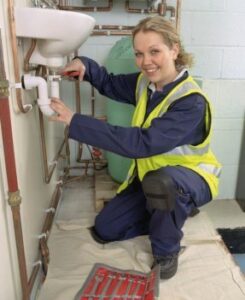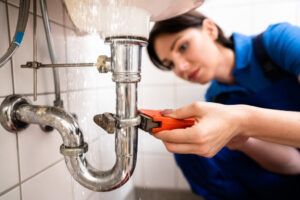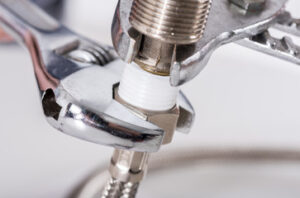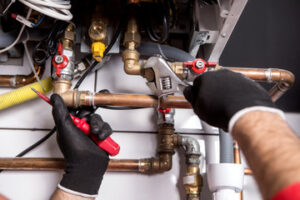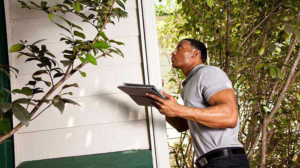Showers and baths would be a lot colder without the plumbing industry. In addition, we owe our lives to plumbers for keeping water-borne diseases at bay, like cholera.

Plumber installs and repairs piping, fixtures, and appliances in residential and commercial settings. They follow blueprints and building codes to make sure everything is connected properly.
A plumbing system is a complex network of pipes that bring water in and drain waste out. The two main parts of a plumbing system are the freshwater supply pipes and the drain-waste-vent (DWV) pipes. Freshwater pipes connect to your faucets and showers, while the DWV pipe carries wastewater to the sewer or septic tank. It’s important to understand how a plumbing system works so you can identify and fix problems when they arise.
Plumbing systems have evolved over the years, but they continue to use basic principles such as gravity and pressure. As new technologies develop, plumbers use them to improve the efficiency of systems and keep up with regulations. Plumbers use specialized tools to help them work more quickly and effectively, such as pipe wrenches, flaring pliers, tubing cutters, pipe bending machines, soldering torches, crimp tools and video cameras.
Modern plumbing systems are made from a variety of materials, including copper, plastic and cast iron. Each type of material has its own advantages and disadvantages, so your plumber will advise you on the best options for your home. For example, copper pipes are durable and resistant to corrosion, but they’re more expensive than other materials. Plastic pipes are lightweight and easy to install, but they can be susceptible to damage from sharp objects. Cast iron pipes are heavy and sturdy, but they can rust over time.
A key part of any plumbing system is the water meter and the main plumbing valve. The water meter registers how much water you use, while the main shut-off valve allows you to stop the flow of water in an emergency. The main plumbing valve is usually located close to the water meter. It’s important to know where this valve is so you can shut off the water in an emergency.
The plumbing system also includes vent pipes that carry air to keep the drains flowing freely. If your toilets or sinks drain slowly or emit a foul smell, the vent pipe may be blocked. A plumber can clear the blockage and restore proper ventilation.
Plumbing Fixtures
A plumbing fixture is a device that is connected to the water supply system and serves a specific function. They can include sinks, faucets, toilets, tubs and showers, as well as appliances like washing machines and dishwashers. Plumbing fixtures are essential for water supply and waste management in homes and buildings. Choosing the right ones will ensure that they are functional, durable and complement the style and design of the space.
A good plumber will help you select the best fixtures for your home, based on your needs and preferences. For example, you may want to choose low-flow fixtures to reduce your water bills. Or, you might prefer to install high-efficiency fixtures that are more environmentally friendly. You should also consider the type of materials used to manufacture the fixtures, as this can affect their durability and performance.
Fixtures should be installed properly to avoid water leaks and other problems. They should be installed with proper clearances from finished walls and other fixtures, and they must comply with local and national plumbing codes. In addition, a good plumber will make sure that the fixtures you choose are compatible with your water supply system and the type of water you use in your home.
It is important to understand the number of plumbing fixtures you will need for a particular space before you begin the installation process. This will help you plan your budget and schedule accordingly. In most cases, the total number of plumbing fixtures will be limited by the size of your home or the capacity of your water supply line. However, if you are building a new home or installing a new plumbing system, the number of fixtures will be determined by the size of the water heater and the capacity of your water supply line.
It is also important to consider the number of fixtures that will be connected to a single vent stack. It is generally recommended that no more than three or four fixtures share a vent stack to prevent the accumulation of wastewater and other debris inside the pipes and vent.
Plumbing Inspections
When a plumbing inspector comes to your home to check the plumbing system, they will use various techniques to inspect all parts of the system. The inspection will include checking all fixtures, water supply lines, and drains for leaks and damage. In addition, the plumber will test the water pressure to ensure that it is within the normal range.
A professional plumber will be able to identify potential problems with your plumbing system and recommend the best course of action for repair or replacement. This can save you money in the long run by catching issues before they cause serious and expensive damage. In addition, if you are selling your home, having a plumbing inspection performed can help to reassure buyers and boost your sale price.
The plumber will start by examining all the water supply fixtures in your home, including sinks, bathtubs, showers, toilets, and outside spigots for leaks or damage. They will also look at the location of the water meter and test all the water outlets to make sure they are working properly. The plumber will also inspect the water heater for proper function and safety. They will also look at the venting for any problems that may need to be addressed.
Plumbing inspectors can also help with preventative maintenance by identifying small leaks before they become bigger problems. This can prevent significant damage and even water waste. In addition, a plumber can help you develop a schedule for routine maintenance so that you don’t have to worry about unexpected problems.
A plumbing inspection is a great idea before buying a new home or making major renovations to an existing one. A plumber can give you a full report of the state of your plumbing system, which will be very helpful in negotiating with the seller or contractor. The report can also be used to help plan for future upgrades or repairs.
If you are a homeowner, it is recommended that you have a plumbing inspection done at least once every five years. This will ensure that your plumbing is in good condition and identify any issues early on.
Plumbing Repairs
While many plumbing problems have easy solutions that homeowners can do themselves, some require the expertise of a professional. Plumbers perform a variety of repairs, including fixing leaks, unclogging drains and toilets, and installing water filters and garbage disposals. They also inspect sewer and drainage systems to ensure they are functioning properly.
Some plumbing repairs are major, such as repiping an entire home’s piping system. In this case, plumbers must remove old piping and install new pipes, which involves cutting through floors, walls and ceilings. Plumbers often use hand tools for this process but may need power tools for larger jobs, such as cutting through concrete. They also need to take into account the current water flow and pressure when determining how to route the new pipes.
Plumbers can also repair or replace plumbing fixtures, such as sinks, bathtubs, showers and toilets. This can include replacing or repairing faucets, shower heads, handles, valves and other components. They may also install or repair appliances such as dishwashers and washing machines. When repairing or replacing fixtures, plumbers must consider the materials used and how they will affect the water quality. For example, older pipes are more likely to have lead in them, which can cause health problems if not removed.
Plumbing contractors also repair or replace outdoor plumbing systems, such as garden hoses and sprinkler systems. They are sometimes called upon to install or repair heating systems, as well.
Some plumbers work directly with customers, providing advice and estimates for plumbing services. This can involve explaining how a particular fixture works or offering suggestions for improvements. It also includes answering questions about how to maintain a plumbing system and interpreting building plans and codes for clients. Other plumbers are employed by companies, such as construction firms, and are responsible for the installation of entire plumbing systems for new buildings or renovation projects. These plumbers typically need to have more experience and training than residential plumbers. They are also usually required to be licensed by their state or municipality.
